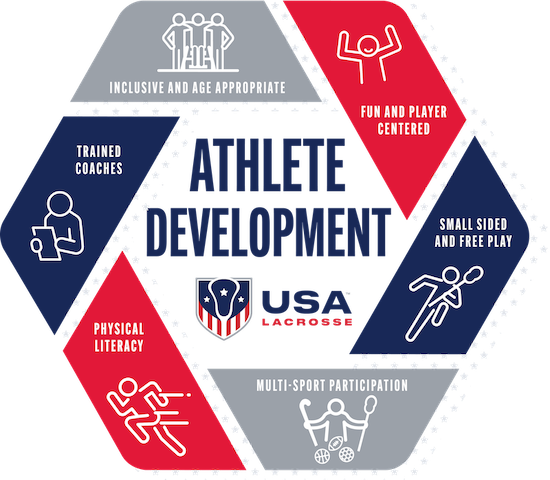The right lacrosse at the right time
Athlete development is a framework using six core values which bring out the full athletic potential in every player. When these values are embraced, players learn the sport better, love it more, and play it longer. Following the core values of athlete development keeps more players engaged in the sport longer and allows the best player to emerge as they reach physical maturity.

Core Values
Athlete Development Stages
Stage 1 - Athlete Development
Discovery: Gives the youngest players the opportunity to develop basic movement skills like running, jumping, landing, kicking, scooping, throwing and catching in a fun setting, built around informal play and positive reinforcement. Kids play and explore movement through many physical activities.
Stage 2 - Athlete Development
Fundamentals: Allows children to develop their movement ABCs — agility, balance, coordination, and speed — and learn the basics of the game while emphasizing fun, cooperation, and maximum touches with the ball. Kids sample lots of different physical activities and sports.
Stage 3 - Athlete Development
Foundations: This is the “golden age” of learning and sport skill development. Children become less self-centered and are able to reflect on their actions and learn from their mistakes. This is the optimal time to learn and build a large repertoire of lacrosse-specific skills and learn the basic principles of play in a fun, challenging environment. Players sample many physical activities and sports in addition to lacrosse.
Stage 4 - Athlete Development
Emerging Competition: This is the stage in which we make or break the athlete; when children choose to continue participation in the sport. This is the time for developing strong technical skills and is the dawning of tactical awareness. Players are also introduced to concepts like mental preparation, goal setting, and coping with winning and losing. Players learn advanced technical skills and position-specific techniques. The major focus is on applying skills, strategies and tactics from practice to competitive situations. Athletes participate in several sports throughout the year or in a variety of physical activities.
Stage 5 - Athlete Development
Competitive: Players are now fine tuning their lacrosse skills under a variety of competitive conditions in a game format that mirrors adult play. Along with continued refinement of advanced techniques, players work to develop their tactical awareness, discipline and mental toughness. They are honing their performance in competition during this stage. Athletes may start to focus on one or two key sports or continue with a variety of physical activities.
Stage 6 - Athlete Development
High Performance (19+): In this stage athletes are ready to maximize fitness preparation and sport/position-specific skills for performance on demand. The focus of practice and training is fully on optimal performance. Training programs are intense but periodized to prevent injury and burn out. Athletes are mainly focused on one sport for high performance.
Participate and Succeed (19+): Athletes who pursue a less intense path than high performance but have the ability, confidence and desire are able to compete at a level appealing to them. Athletes can focus on performance excellence, fitness preparation, and can maximize sport and position specific skill performance for the level of competition. Athletes may choose lacrosse as the primary sport or may still engage in other competitive endeavors.
All Stages - Athlete Development
Lifetime Engagement: Making the transition from physically literate and confident lacrosse athlete to lifelong participant in sport whether it be competitive for life, fit for life, or also engaging as a coach, official, program leader or supporter of the sport. This occurs from the athlete having a positive lacrosse experience in the other stages of development.
News

TrueSport | Parents | Athlete Development
| Jan 31, 2025
Parents: 6 Ways to Make Sure Youth Sport is Delivering on Your Expectations
Read StoryParents: 6 Ways to Make Sure Youth Sport is Delivering on Your Expectations
Jan 31, 2025

TrueSport | Parents | Athlete Development
| Jan 31, 2025
Parents: 6 Ways to Make Sure Youth Sport is Delivering on Your Expectations
Read StoryUSA Lacrosse Adds Two Additional U15 Regional ID Clinic Locations
Jan 29, 2025

Press Release | NTDP | National Teams
| Jan 29, 2025
USA Lacrosse Adds Two Additional U15 Regional ID Clinic Locations
Read StoryChris Dax Named VP of Philanthropy for USA Lacrosse
Jan 28, 2025

Press Release | Foundation | Donors
| Jan 28, 2025
Chris Dax Named VP of Philanthropy for USA Lacrosse
Read StoryFree Rules Interpretation Webinar Sessions Still Available
Jan 28, 2025

Rules | Press Release | Coaches | Officials
| Jan 28, 2025




